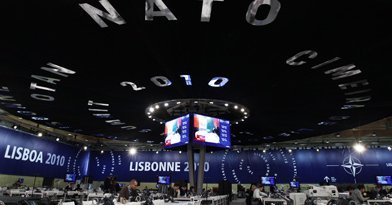Security is an indiscriminate concern of all nations. NATO’s expansion at an end?
The root critique on NATO often stems from the fact that this organisation acts to protect the interests of Western nations and, due to their ‘open door policy’, has little objection to allow democratic and peace-abiding nations close to other Grand Actors’ sphere of influence (Russia, China) to join. A rather unexpected surprise came in June 2009 when in Berlin Russian President Medvedev launched a proposal for a new European Security Pact. The reactions to this offer ranged from lukewarm commentaries to harsher criticism and rebuke. In December 2009 Secretary-General Anders Fogh Rasmussen purported that a new security pact was not required. He argued that the framework for that purpose was already present and that drawing up a new treaty would be futile. Yet Rasmussen kept the door open and said he was “prepared to discuss the ideas in the right forum". It did not really come to a surprise that NATO generally opposes to other actors attempting to imitate the foundations of NATO’s raison d’être.
Critics of the upcoming New Strategic Concept argue that this ‘review’ is just a cosmetic patchwork to NATO’s existing priority scope, engendered by an ever-widening matrix of security challenges and the increase of unconventional warfare, which requires flexible and diversified approaches. The frequency of combined challenges is taken to an unprecedented level, prompting concerns about generating apt response mechanisms. It’s not only a matter of technological assets and know-how, strategies and troops, but very much a question of mobility, resilience and response/intervention timeframes.
Beyond the ‘Atlantic’ scope, ready to embrace a broader collective partnership field?
However, its ever-widening scope (Middle East, Afghanistan, Asia) seems to push the Atlantic organization to re-invent itself and change its initial ‘Western nation states only’ character. The seemingly ‘endless’ ambitions of NATO to safeguard security from San Francisco to Kabul and by appeasing to former Warsaw Pact states has triggered much criticism. After the inception of the NATO-Russia Council (NRC) in 2002, the relationship between NATO and Russia became severed quite badly over the war in Georgia in the Summer of 2008. The degree of polarization about the crisis peaked as the Kremlin spoke threatening language to the government in Tbilisi over their intent to join NATO. Even though the Caucasus issue is far from resolved, NATO’s public diplomacy efforts have carried on non-stop to convince the Russians of an honest intent to cooperate on security issues. And this charm offensive seems to have opened fair prospects, because President Medvedev has announced he will personally attend the NATO Summit in Lisbon. Such a sign of high-level involvement from the Russian government about NATO’s strategic policies has rarely been shown since the dissolution of the Warsaw Pact.
Convergence by necessity or new forms of old-fashioned geopolitics?
The willingness to overcome inter-institutional trifles and obstacles seems to emerge increasingly from security and defence debates. In today’s era of austerity measures and budget cuts, there is a rising necessity to rationalize security and defence spending and pursue mergers of national defence research and development as well as training programs. One clear example is the Franco-British defence pact signed on 2nd November 2010 by President Nicolas Sarkozy and Prime Minister David Cameron. The pact envisions the creation of a joint French-British military force, the sharing of nuclear testing facilities and mutual use of an aircraft carrier. This move indicates that the past mutual distrust and disagreements between both nations has rescinded. Defence Ministers across Europe and beyond are convening more frequently. They acknowledge the need for multilateral defence cooperation and endorse the sharing of best practices and exchange of ideas on improving capacities beyond the field demarcations of Common Foreign and Security Policy (CFSP). Examples are the conference of Ministers of Defence in Ghent on 28 September and a EU security and defence round-table conference [1] in Warsaw on 28 October.
Looming ‘depth charges’ underneath the EU-NATO relationship and a need to foster more security partnerships for the Near Abroad
However, these increasing signals of heightened collaboration do not hide the fact that the EU-NATO relationship still faces many hamperings. With 21 of the 27 EU member states also being NATO members, there is a tendency to make Common Security and Defence Policy institutions of the EU (CSDP) to closely resemble the NATO structures. The North Atlantic Council (NAC, NATO’s principal political decision-making body) has its pendant in the EU Political and Security Committee (COPS). The NATO Parliamentary Assembly keeps firm relations with its EU counterpart, the Subcommittee on Security and Defence (SEDE) at the European Parliament. The restructured NATO Defence Policy and Planning Committee (formerly DAC) is mirrored by the Concepts and Capabilities Directorate (CON/CAPS) within the EU Military Staff. Yet, while the EU offers a more broader platform to achieve policy outcomes, NATO mainly operates for them as a mutual protection clause.
The EU needs to bolster its growth in terms of military and crisis response capabilities for a substantial transition period, during which it can still rely on NATO’s capacities when the need arises.
The European Defence Agency (EDA) is currently working hard to identify key areas where force capability development for the EU can be furthered (the so-called EDTIB, European Defence and Technological Industrial Base). The EU needs to bolster its growth in terms of military and crisis response capabilities for a substantial transition period, during which it can still rely on NATO’s capacities when the need arises. This is particularly vital when the EU’s interests in the ‘Near Abroad’ are at stake and non-NATO EU members face numerous dynamic and hard to predict security threats. For hybrid crisis operations involving more civilian assets (personnel, IT) and planning/monitoring facilities, the EU is bound to seek aid with non-allied partners. NATO’s intention to build up more civilian capacities has been entrenched, because many members are not eager to train military forces as a gap-filler when local civil support is too weak or absent. In their view, a NATO Response Force can operate as a peacekeeper but is not designed to remove rubble or install a water pump when no one else takes care of that.
Setting a more coherent course. The need to foster proactive and reinforced security alliances.
Many nations don’t object to giving contributions both to the EU and NATO regarding matters of security and defence. This duplicity is legitimized through the paradigm that it is always better to have two insurance policies instead of only one. Like Dr. Catriona Gourlay (International Security Information Service) points out, it is time that the EU stops being merely reactive in the field of security or crisis response and instead sets out a more proactive policy approach for its foreign operations. Although previous delay problems between decision-making and actual implementation have been improved, it appears that the EU still does not know what it is prepared to do (think of the friction over use of ISAF forces in Afghanistan), nor has it found a clever fair way to combine the various, capacities and perspectives. Such and many other obstacles must be tackled first, or otherwise the EU and NATO will both face the bases of legitimacy crumbling beneath themselves. It is time to supersede internal uncertainties and show openness to trust and forge partnerships with more emerging powers. The EU can seek to consolidate its approach to security and defence, and must find ways to fit in the various ‘strategic cultures’ of its allies.


Follow the comments: |
|
